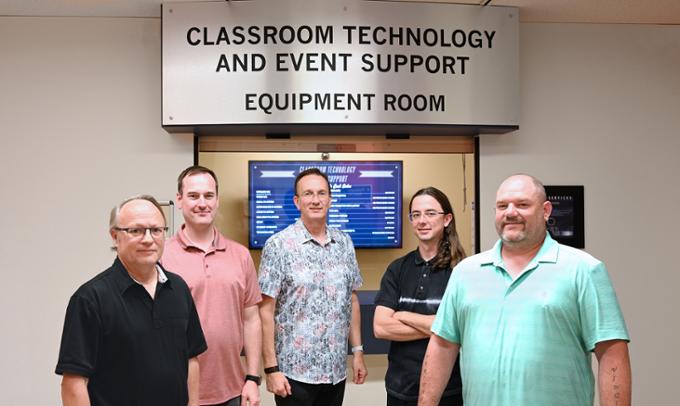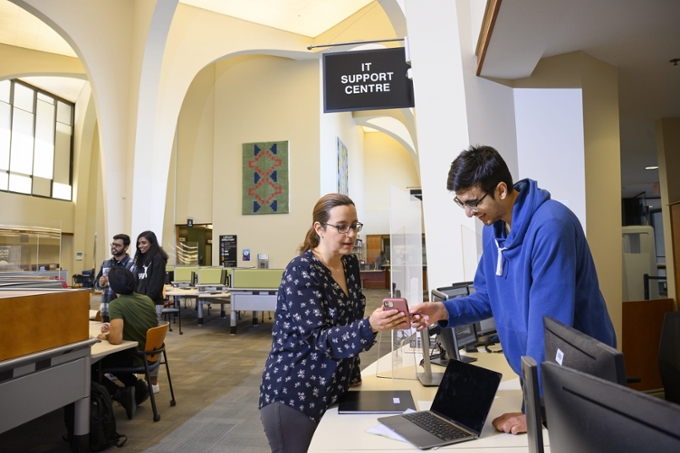
Information Services
M365 is Free for Registered Students
Multi-factor Authentication (MFA) Mandatory
- Quick Setup: Load the Free version of the Microsoft Authenticator app on your mobile device, log in with your username@uregina.ca and current password.
- This is for registered Students with M365 Accounts, and includes Outlook email.
M365 Apps for Students
- Active (registered) students with an @uregina.ca email address can access M365 online and download the full Microsoft Office suite on up to 5 devices.
Outlook Email
- Microsoft Outlook is used for your University of Regina email. Sign in with your uregina M365 account username@uregina.ca and current password.
- Log in to computers in the computer labs is username@uregina.ca and your current password.
Grad Students
New Students
System Outages and Maintenance
Contact and Hours Information
IS Service Desk provides a variety of services and assistance to students regarding accounts, logins, passwords, outlook email, WiFi (eduroam) and internet access, public labs, and printing. We ensure your concern is recorded, assigned, and addressed in a timely manner.
There are two Locations on Campus where you can get Technical Assistance
- IS Service Desk is located in the Education Building, main floor, ED 137.
- Dr. John Archer Library Help, is located left of entrance doors, main floor commons. The library also has many public computers and printers for student use.
IS Service Desk
Phone: 306-585-4685
Toll-free in Canada: 1-844-585-4685
Email: Service.Desk@uregina.ca
Phone-In Hours
Monday - Thursday: 7:30 AM - 10 PM
Friday: 7:30 AM - 9:45 PM
Saturday & Sunday: 9 AM - 9:45 PM
IS Service Desk
Education Building 137
In-Person Hours
Monday - Friday: 7:30 AM - 4:30 PM
Dr. John Archer Library
IS Service Desk Help
In-Person Hours
Monday - Friday: 8:30 AM - 9:45 PM
Saturday & Sunday: 9 AM - 9:45 PM
Connect With Us
IS Service Desk Quick Tips
- If you suspect you have a virus, malware, or adware on your computer system, or if you received a ticket notification from IT Support that your system has been blocked from the network, there are several online tools you can use to scan and clean your system.
- Network access can be restored by the IT Support Centre, once you have provided confirmation that you have mitigated the issue.
- If you would prefer assistance, or if your scanning was not successful in removing the malware, the IT Support Centre can provide basic removal of typical viruses for a fee.
- Virus removal cost is $25, which will be charged to your student account and payable at Financial Services. You will be required to provide proof of payment prior to picking up your device.
Note: Some viruses/trojans are almost impossible to remove, and some may return if the same activity is repeated. We do not guarantee that the work will be successful. If re-installation of the operating system is required to mitigate the virus, we will not be able to complete the work for you.
Information Security provides further information and resources for protecting your device from virus' and malware.
- At this time, we do not provide computer technical support for student-owned computers and laptops.
- Grad Students working with Faculty may be assigned a University-owned computer or laptop and may need hardware and software support, see Grad Student Hardware and Software Information.
Duo and Zoom are both restricting service from users whose IP addresses originate in a country or region subject to economic and trade sanctions enforced by the U.S. Office of Foreign Assets Control.
OFAC restrictions relevant to Zoom currently apply to the following countries or regions:
- Cuba
- Iran
- North Korea
- Syria
- Ukraine (Crimea, Donetsk and Luhansk regions)
This includes remote access via the U of R VPN, and RDP. UR Courses can be affected for students. For more information on Zoom restrictions, visit the Zoom Support website.
OFAC restrictions relevant to Duo MFA currently apply to the following countries or regions (Employees use MFA to access U of R applications) https://www.uregina.ca/is/mfa/mfa-applications.html:
- Cuba
- North Korea
- Iran
- Sudan
- Syria
- Crimea region
- Sevastopol region
- Donetsk region
- Luhansk region
Cybersecurity Tips
Information Services at the University of Regina is pleased to announce the University Password Management Policy effective February 26, 2018.
The new policy applies more stringent security controls for passwords based on information sensitivity of IT systems accessed by University of Regina users.
This policy consolidates password management controls to encompass all University applications and is applicable to all faculty, staff, students, and affiliates. It consists of 3 documents; the governing Password Policy (OPS-050-035 and two supporting technical standards.
Password complexity and length should take into account the sensitivity and importance of the systems that the authorization is intended for. The more important, the longer the password should be in addition to the use of a mix of upper and lower case with special characters and numbers. It is better not to reuse passwords that have been used before or are used on other accounts. Using the same password on multiple accounts increases the risk of compromise.
Your new password is required to satisfy the following:
- Minimum 8 characters for students, 10 characters for employees, 16 for employees in High-risk areas.
- Maximum 30 characters.
- Must contain at least three out of four of uppercase, lowercase, numeric and special characters
- Password must not include the special characters: @ $ \ " ' < > ;
- The new password should have at least 2 new characters compared to the old one, and at least one change in the first 8 characters.
- Cannot contain first name, last name, username, or birth date
- Cannot contain any 4 digits found in student/employee ID
- Cannot contain any sequence of increasing or decreasing digits greater than 3 (1234XX or XX4321 for example)
- Cannot contain any character repeated three or more times
- Locate a "Report" button for Phishing or Malware in the top navigation of Microsoft Outlook (email) and select "Report" to submit a report for phishing emails.
- Alternatively, forward the suspicious email as an attachment to Report.phishing@uregina.ca
Printing Services
Printing experts providing extensive print solutions
Administration-Humanities Building 118
Phone: 306-585-4488
Fax: 306-585-4780
Email: Printing.Services@uregina.ca
In-Person Hours
Monday to Friday 8:15 AM - 4:30 PM

Classroom Technology and Event Support (CTES)
We provide support for classroom technology and events for the University of Regina
Education Building, 166
Phone: 306-585-4476
Email: CTES@uregina.ca
In-Person Hours
Monday - Friday 8:15 AM - 4:30 PM
Evenings
Monday - Thursday 6:30 PM - 10:00 PM
(during Fall and Winter Semesters)
Closed on Holidays
Information Security & Cyber Security
- Phishing, viruses, and malware
- Campus Cyber Advisories.
- Information Security Policies & Standards
- Technology Risk Assessments
- Cybersecurity Resources.
- Reporting Information Security Incidents.
Report Phishing
- Locate a "Report" button for Phishing or Malware in the top navigation of Microsoft Outlook (email) and select "Report" to submit a report for phishing emails.
- Alternatively, forward the suspicious email as an attachment to Report.phishing@uregina.ca

